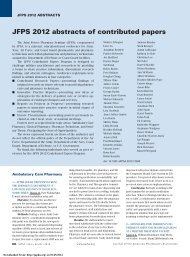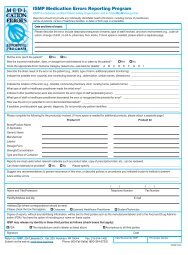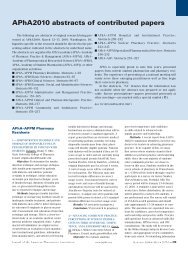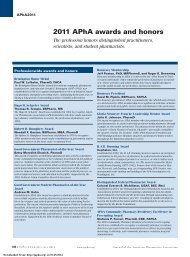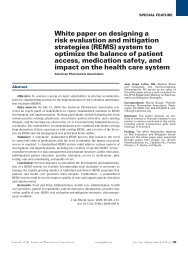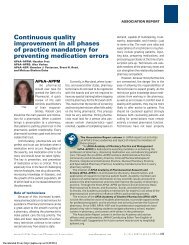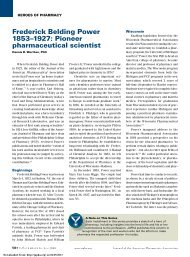Downloaded - Journal of American Pharmacists Association
Downloaded - Journal of American Pharmacists Association
Downloaded - Journal of American Pharmacists Association
Create successful ePaper yourself
Turn your PDF publications into a flip-book with our unique Google optimized e-Paper software.
Annual Meeting Abstracts 2004<br />
FEATURE<br />
Objective: To evaluate the analgesic efficacy and<br />
safety <strong>of</strong> three dose levels <strong>of</strong> oxymorphone immediate<br />
release (IR) compared with oxycodone IR and<br />
placebo in patients with moderate to severe postoperative<br />
pain following total hip or knee replacement<br />
surgery.<br />
Methods: This Phase III, double-blind, parallelgroup<br />
study included single- and multiple-dose<br />
parts. Opioids were terminated the day following<br />
surgery and patients developing moderate to severe<br />
pain within 9 hours were randomized to one <strong>of</strong> five<br />
groups: oxymorphone IR 10 mg, 20 mg, or 30 mg;<br />
oxycodone IR 10 mg; or placebo. Single-dose efficacy<br />
measures included total pain relief (TOTPAR)<br />
up to 8 hours or until remedication. Patients requiring<br />
remedication after 3 hours received drug every 4<br />
to 6 hours for 48 hours for multiple-dose evaluation;<br />
placebo patients were rerandomized to active treatment.<br />
Multiple-dose efficacy was based on worst<br />
pain and global evaluations.<br />
Results: During the single-dose phase (N = 258),<br />
all oxymorphone doses were statistically superior to<br />
placebo for most end points including TOTPAR 0–8<br />
scores (P = .05 for 10 mg and P = .001 for 20 and 30<br />
mg) and a statistically significant dose-response was<br />
observed (P < .001). The median time to meaningful<br />
pain relief was significantly shorter in all oxymorphone<br />
groups (1 hour) than in placebo (1.5 hours; P<br />
= .05). Treatment with oxycodone 10 mg was not<br />
significantly different than placebo. Adverse events<br />
were typical <strong>of</strong> opioid medication. During the multiple-dose<br />
phase (N = 161), analgesia was maintained<br />
in all groups over 48 hours. The median dosing<br />
interval was more than 9.5 hours for oxymorphone<br />
IR 30 mg and between 7 and 8 hours for the other<br />
groups. Opioid-related adverse events were similar<br />
between groups.<br />
Conclusions: Oxymorphone IR provides significant<br />
pain relief with the first dose <strong>of</strong> 10 mg, 20 mg,<br />
or 30 mg and maintains analgesia over consecutive<br />
days with multiple doses. Adverse events were mild<br />
to moderate and dose related.<br />
Original Citation: Poster Presentation: <strong>American</strong><br />
Pain Society Annual Meeting; March 18–23, 2003;<br />
Chicago, Illinois.<br />
22—LONG-TERM EFFECTIVENESS AND<br />
SAFETY OF A NEW ORAL OPIOID, OXY-<br />
MORPHONE EXTENDED RELEASE, FOR<br />
MODERATE TO SEVERE CANCER PAIN.<br />
Slatkin N, City <strong>of</strong> Hope National Medical Center,<br />
Amy F, Ma T, Ahdieh H, Endo Pharmaceuticals,<br />
Inc. E-mail: noellecurry@excite.com<br />
Objective: To evaluate the long-term effectiveness,<br />
safety, and dosing requirements <strong>of</strong> oxymorphone<br />
extended release (ER), a new formulation <strong>of</strong><br />
oxymorphone, in cancer patients with chronic pain.<br />
Methods: Cancer patients with moderate to<br />
severe chronic pain who completed a previous randomized<br />
controlled trial and met study criteria<br />
entered a 2-year, open-label, extension study <strong>of</strong> oxymorphone<br />
ER every 12 hours. Patients began openlabel<br />
treatment with the oxymorphone ER dose<br />
attained in the previous study and were allowed to<br />
titrate to achieve acceptable pain relief.<br />
Oxymorphone immediate release was available as<br />
rescue medication throughout the study.<br />
Effectiveness was assessed by pain intensity scores<br />
and patient global assessment <strong>of</strong> study medication.<br />
Results: Of 44 enrolled patients (mean age = 54<br />
years), 16 completed 52 weeks <strong>of</strong> treatment, with a<br />
median time to discontinuation <strong>of</strong> 249 days.<br />
Concomitant disease progression and other serious<br />
adverse events unrelated to study medication caused<br />
the most withdrawals over the 2 years. Patient pain<br />
was well controlled throughout the first year with<br />
every-12-hour doses <strong>of</strong> oxymorphone ER (approximate<br />
weekly average score <strong>of</strong> 30–35 mm on 100 mm<br />
visual analog scale). The mean dosage was 125<br />
mg/day during days 0–30 and 150 mg/day during<br />
days 331–360. The mean dose <strong>of</strong> oxymorphone IR<br />
rescue medication was low (23 mg/day) during the<br />
same time period. At each study visit, 90% or more<br />
<strong>of</strong> patients rated study medication as “excellent,”<br />
“very good,” or “good” at relieving pain. Adverse<br />
events associated with opioid use included nausea,<br />
vomiting, constipation, and sedation.<br />
Conclusions: Oxymorphone ER is safe and effective<br />
in cancer patients with moderate to severe<br />
chronic pain when used long-term. Stable pain<br />
scores were maintained with little change in scheduled<br />
medication and with minimal rescue medication.<br />
Patients reported overall “excellent” to “good”<br />
satisfaction with oxymorphone. Oxymorphone ER<br />
provides a new, effective, and safe opioid treatment<br />
for moderate to severe chronic cancer pain.<br />
23—LONG-TERM EFFECTIVENESS AND<br />
SAFETY OF A NEW ORAL OPIOID, OXY-<br />
MORPHONE EXTENDED RELEASE, FOR<br />
MODERATE TO SEVERE OSTEOARTHRI-<br />
TIS PAIN. Mcilwain H, Tampa Medical Group<br />
Research, Ahdieh H, Endo Pharmaceuticals, Inc. E-<br />
mail: vrisman@hotmail.com<br />
Objective: To evaluate the long-term effectiveness,<br />
safety, and dosing requirements <strong>of</strong> oxymorphone<br />
extended release (ER) in patients with moderate<br />
to severe chronic osteoarthritis (OA) pain uncontrolled<br />
by nonopioid analgesics.<br />
Methods: OA patients with moderate to severe<br />
chronic pain who previously completed a randomized<br />
double-blind trial and met study criteria entered<br />
a 2-year open-label extension trial <strong>of</strong> oxymorphone<br />
ER. Patients were either on active drug in the previous<br />
study and began open-label treatment at their<br />
prior stabilized dose, or had previously received<br />
placebo and began open-label treatment at oxymorphone<br />
20 mg every 12 hours. Least, worst, and average<br />
pain intensity scores and dosage amounts were<br />
recorded. Effectiveness was assessed by pain intensity<br />
scores and patient global assessment <strong>of</strong> study<br />
medication.<br />
Results: The study included 153 patients with a<br />
mean age <strong>of</strong> 60 years. Of these, 61 patients completed<br />
52 weeks, and 16 <strong>of</strong> 29 patients (55%) enrolled in<br />
year 2 completed the study. After an initial decrease<br />
from baseline, the mean recall scores <strong>of</strong> the least and<br />
worst pain remained stable during the first year, and<br />
the median daily dose <strong>of</strong> medication stabilized at 40<br />
mg. More than 80% <strong>of</strong> patients rated oxymorphone<br />
as “excellent,” “very good,” or “good” at each visit.<br />
Most withdrawals (n = 49, year 1) were caused by<br />
adverse events typically associated with opioid medications,<br />
but 47% <strong>of</strong> these patients (23) had received<br />
placebo in the prior study.<br />
Conclusions: Oxymorphone ER presents a new<br />
alternative for the treatment <strong>of</strong> moderate to severe<br />
chronic OA pain, and tolerability in clinical practice<br />
can likely be improved by initiating opioid-naive<br />
patients with doses lower than 20 mg every 12 hours.<br />
Long-term use <strong>of</strong> oxymorphone ER was safe and<br />
effective in patients with OA with moderate to<br />
severe chronic pain, and patients maintained control<br />
<strong>of</strong> pain with a stable twice-daily doses <strong>of</strong> medication<br />
for 1 year.<br />
24—TOLERABILITY AND EFFECTIVE-<br />
NESS OF OXYMORPHONE EXTENDED<br />
RELEASE IN OPIOID-NAIVE PATIENTS<br />
WITH CHRONIC PAIN. Hale M, Gold Coast<br />
Research, L.L.C., Nagle B, Photivihok G, Endo<br />
Pharmaceuticals, Inc., Drass M, Center for Pain<br />
Management. E-mail: noellecurry@excite.com<br />
Objective: To assess the tolerability and effectiveness<br />
<strong>of</strong> oxymorphone extended release (ER) following<br />
titration from a low dose (5 mg every 12<br />
hours) in opioid-naive patients with moderate to<br />
severe chronic pain.<br />
Methods: This open-label nonrandomized study<br />
is being conducted in patients 18 years <strong>of</strong> age or<br />
older with an initial pain intensity score <strong>of</strong> 40 or<br />
more on a 100-mm Visual Analogue Scale and a<br />
pain rating <strong>of</strong> moderate or severe on a categorical<br />
scale. Patients must be opioid-naive (no prior opioid<br />
use within the past 3 months) and suboptimally<br />
responding to nonopioid analgesics. Patients initiate<br />
2 days <strong>of</strong> therapy with oxymorphone ER 5 mg every<br />
12 hours. Starting on day 3, patients will be titrated<br />
to a stable dose <strong>of</strong> oxymorphone ER that provides<br />
meaningful pain relief (4 or more on a 0 to 10 scale<br />
for 3 <strong>of</strong> 5 consecutive days). The titration period is<br />
not to exceed 21 days. No changes are made in concomitant<br />
nonopioid analgesics during this period.<br />
Following titration, patients are maintained with the<br />
stabilized dose <strong>of</strong> oxymorphone ER therapy for up to<br />
6 months. Oxymorphone immediate release 5 mg is<br />
available as rescue medication during the maintenance<br />
period only. Concomitant nonopioid analgesics<br />
can be decreased or discontinued but not<br />
increased, and no new nonopioid analgesics can be<br />
added during the maintenance period. Tolerability<br />
will be assessed by the rate <strong>of</strong> discontinuations<br />
because <strong>of</strong> adverse events. Additional assessments<br />
will include average daily pain intensity, average<br />
daily dose <strong>of</strong> oxymorphone ER, rescue medication,<br />
time to stabilization, and patient and physician global<br />
assessments.<br />
Results: Data will be presented for approximately<br />
100 patients.<br />
Conclusions: Conclusions will be presented<br />
based upon the trial results, and the implications for<br />
pharmacists will be discussed.<br />
2004 Abstracts <strong>of</strong> Contributed Papers<br />
Vol. 44, No. 2 March/April 2004 www.japha.org <strong>Journal</strong> <strong>of</strong> the <strong>American</strong> <strong>Pharmacists</strong> <strong>Association</strong> 231<br />
<strong>Downloaded</strong> From: http://japha.org/ on 01/25/2014



